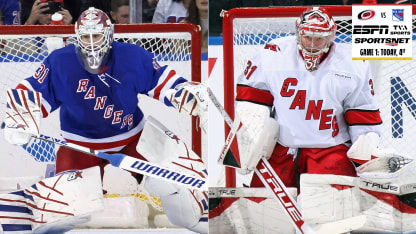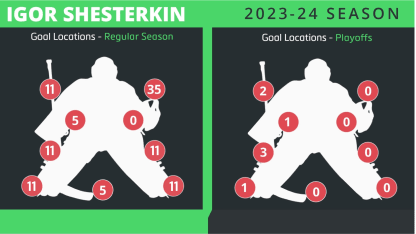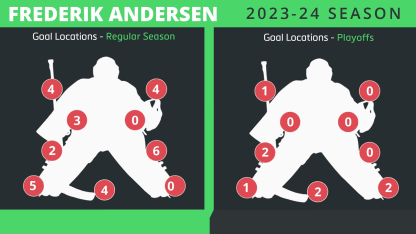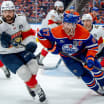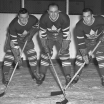High glove, not blocker: Don’t be fooled by the zero above Shesterkin’s glove in the first round against Washington. The 35 percent that went in above his glove among his final 100 goals of the regular season are almost 12 percent above the tracked average for more than 6,800 goals since this project started in 2017. While some of that is due to the inherent nature of players aiming for the top corners because every goalie drops into a butterfly, there was a notable discrepancy between the glove and the blocker side, which Shesterkin has been consistently great at protecting, especially high. Shesterkin starts with his glove up near his shoulder but tends to drop it onto his hip, especially if he’s moving laterally into his stance (14 of the 35 high-glove goals came off cross-ice play and passes). Despite that, the Capitals directed almost twice as many shots to the blocker side, a trend the Hurricanes would be wise not to repeat.
Low-high, below bottom of circles: Passes from below the goal line below the bottom of the face-off circles accounted for 23 percent of the tracked goals, and two of seven in the playoffs (28.6 percent), both above the average of 17.1 percent. Shesterkin is one of the NHL’s best skaters, so plays that force him back to his posts before a low-high pass can delay his ability to get out and set as cleanly as he normally would. It helps explain why lateral plays below the hash marks led to more goals (14) than cross-ice plays higher in the zone (four). Carrying the puck deep on rush chances can also work, as he tends to overlap his post with his outside skate as it gets below the circle, creating a big rotation and push if the puck is moved laterally.
Get it up: It’s also important not to read too much into the 22 goals tracked as going in along the ice to either side of Shesterkin because it’s not as though he was beat cleanly on all of them; these are also used to indicate plays where he was caught out of position and couldn’t recover in time laterally. He can get caught out near the edge of his crease on scramble plays and shots that hit traffic in front, which accounted for 21 percent of his goals in the regular season and three of seven (42.9 percent) in the playoffs, well above the 14 percent tracked average. So, it’s a good idea to funnel loose pucks to a teammate off to the side, but Shesterkin is one of the best moving from his knees and usually gets a glove over that lead pad when he pushes side to side, so shooting along the ice even on lateral plays gives him a chance to make a momentum-changing highlight save.
Against the grain: Shots and tips to the opposite side of Shesterkin’s movement accounted for 23 percent of the tracked goals, and two of seven (28.6 percent) against the Capitals, and though those are inherently tough scoring chances, both numbers were above the 18.5 percent tracked average.
